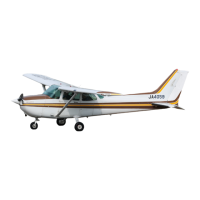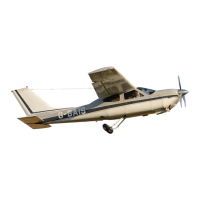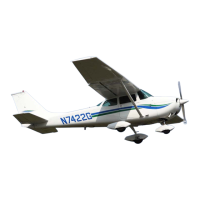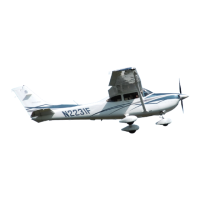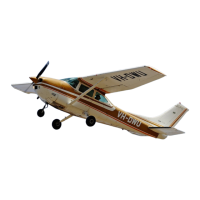Do you have a question about the Cessna 177 and is the answer not in the manual?
Lists various speed parameters including Top Speed and Cruise Speed.
Details climb performance at sea level, including Take-off and Landing.
Information on payload capacity, baggage, fuel, and engine details.
Specifies max gross weight, empty weight, useful load, fuel capacity, and rating.
Details engine type, horsepower, and aircraft battery voltage.
Provides CG and CG Moment data for the empty aircraft.
Outlines warranty, factory personnel, and approved equipment/parts.
Guides the pilot through essential pre-flight and operational checks.
Details specific preflight checks for various aircraft sections.
Lists preflight checks for the aircraft cabin interior.
Lists preflight checks for the left wing components.
Lists preflight checks for the aircraft's tail section.
Lists preflight checks for the right wing components.
Lists preflight checks for the nose section of the aircraft.
Steps to perform before starting the aircraft engine.
Procedures for starting the aircraft engine.
Checks to perform before taxiing the aircraft.
Procedures and checks to perform before taking off.
Information to convey to passengers before flight.
Standard procedure for taking off the aircraft.
Procedures for taking off from a short runway.
Procedures for climbing during the enroute phase of flight.
Flight procedures for cruising at altitude.
Procedures for descending during flight.
Checks and procedures to perform before landing.
Procedures for aborting a landing and initiating a go-around.
Standard procedures for landing the aircraft.
Steps to take after the aircraft has landed.
Procedures for clearing the runway after landing.
Steps to take before parking the aircraft.
Procedures for securing the aircraft after parking.
Actions to take in case of engine failure during takeoff.
Actions to take in case of engine failure after takeoff.
Actions to take in case of engine failure during flight.
Actions to take in case of engine fire during flight.
Actions to take in case of electrical fire during flight.
Procedures for conducting an emergency landing.
Procedures for making a precautionary landing.
Explains the function and operation of the aircraft's master switch.
Describes the ammeter's function and how to read its indications.
Explains the over-voltage protection system and warning light.
Explains the function of circuit breakers and fuses within the electrical system.
Covers the aircraft's external lighting systems, including navigation and strobe lights.
Explains the integrated restraint system with inertia reels.
Detailed procedures for starting the aircraft engine.
Procedures for taxiing the aircraft on the ground.
Procedures and checks to perform before taking off.
Procedures for warming up the engine before takeoff.
Standard procedure for taking off the aircraft.
Procedures for taking off from a short runway.
Procedures for checking engine power before takeoff.
Information on appropriate flap settings for takeoff.
References charts for takeoff performance data.
Procedures for taking off in crosswind conditions.
Provides data related to enroute climb performance.
Details optimal airspeeds for climbing.
Discusses normal cruising operations, settings, and data.
Procedures for recovering from intentional spins.
Describes stall characteristics and associated warnings.
Details short field, crosswind, and normal landing procedures.
Procedures for aborting a landing and initiating a go-around.
Procedures for starting the engine in cold weather conditions.
Discusses general flight operations and considerations.
Procedures and considerations for operating the aircraft in hot weather.
Guidelines for minimizing aircraft noise pollution.
Covers engine failures after takeoff and during flight.
Details emergency and precautionary landing procedures.
Procedures for ditching the aircraft safely in water.
Covers engine fires during ground start and in flight.
Procedures for handling electrical fires during flight.
Detailed steps for conducting an emergency landing.
Procedures for handling disorientation while flying in clouds.
Steps for performing a 180-degree turn in cloud conditions.
Procedures for emergency descents through clouds.
Procedures for recovering control from a spiral dive.
Procedures for handling unexpected icing encounters.
Troubleshooting rough engine operation or loss of power.
Procedures for identifying and dealing with carburetor icing.
Procedures for dealing with fouled spark plugs.
Procedures for diagnosing and handling magneto malfunctions.
Procedures for responding to low oil pressure indications.
Discusses malfunctions in the aircraft's electrical power supply system.
Procedures for handling excessive electrical charge conditions.
Procedures for handling insufficient electrical charge conditions.
Procedures for handling the loss of a single display element on the EDM-900.
Procedures for handling the loss of all displays due to electrical failure.
Details the operational modes and functions of the Emergency Locator Transmitter.
Specifies the approved operating conditions, use, and category for the aircraft.
Details maneuvers permitted within the aircraft's normal category.
Lists the certified calibrated airspeed limitations for the aircraft.
Explains the color-coded markings on the airspeed indicator.
Outlines the limitations for engine operation regarding power and speed.
Explains markings for key engine instruments like oil temp and cylinder head temp.
Explains markings for oil pressure, fuel pressure, and fuel quantity gauges.
Explains markings for the tachometer and manifold pressure gauge.
Provides information on calculating aircraft weight and balance.
Diagrams showing loading arrangements and seat positions for weight distribution.
Procedures for securely tying down baggage and cargo within the aircraft.
Diagrams showing loading arrangements and seat positions.
Example calculation for aircraft loading and weight/balance.
General guidance on maintaining the aircraft's performance and condition.
Procedures for safely maneuvering the aircraft on the ground.
Procedures for securing the aircraft when parked using mooring lines.
Instructions for cleaning aircraft windshields and windows.
Guidance on cleaning and maintaining the aircraft's painted exterior surfaces.
Instructions for cleaning the aircraft's aluminum surfaces.
Instructions for maintaining the aircraft propeller's condition.
Information about aircraft identification plates and their codes.
Lists the essential documents to be kept in the aircraft's file.
Procedures for storing the aircraft in a condition ready for flight.
Details required aircraft inspections, intervals, and compliance.
Information on the Cessna Progressive Care maintenance program.
Details the benefits and enrollment in the Cessna Customer Care Program.
Information on notifications and support from the Cessna owner follow-up system.
Lists available Cessna publications, manuals, and aids.
Table for correcting indicated airspeed to true airspeed.
Table showing stall speeds under various conditions and bank angles.
Data related to takeoff performance, including ground run and obstacle clearance.
Data for maximum rate of climb at various altitudes and conditions.
Cruise performance data for extended range operations with various mixtures.
Describes optional equipment available for the aircraft.
Information on equipment for operating in cold weather conditions.
Details the components and purpose of the winterization kit.
Explains the function and use of the ground service plug receptacle.
Details the Garmin GTX 33X transponder family and its capabilities.
Details the Garmin GTX 3X5 transponder family and configurations.
Lists the capabilities of the GTX 33X and GTX 3X5 systems.
Describes the installed interfaces and features of the GTX systems.
Specifies minimum equipment required for ADS-B Out operations.
Details compliance requirements for ADS-B Out functionality.
Explains the functionality of the TIS traffic display with user navigation angle.
Covers software versions, PABI, weather display, and portable devices.
General procedures for handling emergency situations.
Procedures for abnormal system operations like power loss or data loss.
Steps for powering on the GTX unit and verifying system status.
Procedures to perform before takeoff, including system checks.
Explains the behavior of the Traffic Information Service (TIS) feature.
Describes traffic alerts from GTX 345R and G950/1000 systems.
Lists various speed parameters including Top Speed and Cruise Speed.
Details climb performance at sea level, including Take-off and Landing.
Information on payload capacity, baggage, fuel, and engine details.
Specifies max gross weight, empty weight, useful load, fuel capacity, and rating.
Details engine type, horsepower, and aircraft battery voltage.
Provides CG and CG Moment data for the empty aircraft.
Outlines warranty, factory personnel, and approved equipment/parts.
Guides the pilot through essential pre-flight and operational checks.
Details specific preflight checks for various aircraft sections.
Lists preflight checks for the aircraft cabin interior.
Lists preflight checks for the left wing components.
Lists preflight checks for the aircraft's tail section.
Lists preflight checks for the right wing components.
Lists preflight checks for the nose section of the aircraft.
Steps to perform before starting the aircraft engine.
Procedures for starting the aircraft engine.
Checks to perform before taxiing the aircraft.
Procedures and checks to perform before taking off.
Information to convey to passengers before flight.
Standard procedure for taking off the aircraft.
Procedures for taking off from a short runway.
Procedures for climbing during the enroute phase of flight.
Flight procedures for cruising at altitude.
Procedures for descending during flight.
Checks and procedures to perform before landing.
Procedures for aborting a landing and initiating a go-around.
Standard procedures for landing the aircraft.
Steps to take after the aircraft has landed.
Procedures for clearing the runway after landing.
Steps to take before parking the aircraft.
Procedures for securing the aircraft after parking.
Actions to take in case of engine failure during takeoff.
Actions to take in case of engine failure after takeoff.
Actions to take in case of engine failure during flight.
Actions to take in case of engine fire during flight.
Actions to take in case of electrical fire during flight.
Procedures for conducting an emergency landing.
Procedures for making a precautionary landing.
Explains the function and operation of the aircraft's master switch.
Describes the ammeter's function and how to read its indications.
Explains the over-voltage protection system and warning light.
Explains the function of circuit breakers and fuses within the electrical system.
Covers the aircraft's external lighting systems, including navigation and strobe lights.
Explains the integrated restraint system with inertia reels.
Detailed procedures for starting the aircraft engine.
Procedures for taxiing the aircraft on the ground.
Procedures and checks to perform before taking off.
Procedures for warming up the engine before takeoff.
Standard procedure for taking off the aircraft.
Procedures for taking off from a short runway.
Procedures for checking engine power before takeoff.
Information on appropriate flap settings for takeoff.
References charts for takeoff performance data.
Procedures for taking off in crosswind conditions.
Provides data related to enroute climb performance.
Details optimal airspeeds for climbing.
Discusses normal cruising operations, settings, and data.
Procedures for recovering from intentional spins.
Describes stall characteristics and associated warnings.
Details short field, crosswind, and normal landing procedures.
Procedures for aborting a landing and initiating a go-around.
Procedures for starting the engine in cold weather conditions.
Discusses general flight operations and considerations.
Procedures and considerations for operating the aircraft in hot weather.
Guidelines for minimizing aircraft noise pollution.
Covers engine failures after takeoff and during flight.
Details emergency and precautionary landing procedures.
Procedures for ditching the aircraft safely in water.
Covers engine fires during ground start and in flight.
Procedures for handling electrical fires during flight.
Detailed steps for conducting an emergency landing.
Procedures for handling disorientation while flying in clouds.
Steps for performing a 180-degree turn in cloud conditions.
Procedures for emergency descents through clouds.
Procedures for recovering control from a spiral dive.
Procedures for handling unexpected icing encounters.
Troubleshooting rough engine operation or loss of power.
Procedures for identifying and dealing with carburetor icing.
Procedures for dealing with fouled spark plugs.
Procedures for diagnosing and handling magneto malfunctions.
Procedures for responding to low oil pressure indications.
Discusses malfunctions in the aircraft's electrical power supply system.
Procedures for handling excessive electrical charge conditions.
Procedures for handling insufficient electrical charge conditions.
Procedures for handling the loss of a single display element on the EDM-900.
Procedures for handling the loss of all displays due to electrical failure.
Details the operational modes and functions of the Emergency Locator Transmitter.
Specifies the approved operating conditions, use, and category for the aircraft.
Details maneuvers permitted within the aircraft's normal category.
Lists the certified calibrated airspeed limitations for the aircraft.
Explains the color-coded markings on the airspeed indicator.
Outlines the limitations for engine operation regarding power and speed.
Explains markings for key engine instruments like oil temp and cylinder head temp.
Explains markings for oil pressure, fuel pressure, and fuel quantity gauges.
Explains markings for the tachometer and manifold pressure gauge.
Provides information on calculating aircraft weight and balance.
Diagrams showing loading arrangements and seat positions for weight distribution.
Procedures for securely tying down baggage and cargo within the aircraft.
Diagrams showing loading arrangements and seat positions.
Example calculation for aircraft loading and weight/balance.
General guidance on maintaining the aircraft's performance and condition.
Procedures for safely maneuvering the aircraft on the ground.
Procedures for securing the aircraft when parked using mooring lines.
Instructions for cleaning aircraft windshields and windows.
Guidance on cleaning and maintaining the aircraft's painted exterior surfaces.
Instructions for cleaning the aircraft's aluminum surfaces.
Instructions for maintaining the aircraft propeller's condition.
Information about aircraft identification plates and their codes.
Lists the essential documents to be kept in the aircraft's file.
Procedures for storing the aircraft in a condition ready for flight.
Details required aircraft inspections, intervals, and compliance.
Information on the Cessna Progressive Care maintenance program.
Details the benefits and enrollment in the Cessna Customer Care Program.
Information on notifications and support from the Cessna owner follow-up system.
Lists available Cessna publications, manuals, and aids.
Table for correcting indicated airspeed to true airspeed.
Table showing stall speeds under various conditions and bank angles.
Data related to takeoff performance, including ground run and obstacle clearance.
Data for maximum rate of climb at various altitudes and conditions.
Cruise performance data for extended range operations with various mixtures.
Describes optional equipment available for the aircraft.
Information on equipment for operating in cold weather conditions.
Details the components and purpose of the winterization kit.
Explains the function and use of the ground service plug receptacle.
Details the Garmin GTX 33X transponder family and its capabilities.
Details the Garmin GTX 3X5 transponder family and configurations.
Lists the capabilities of the GTX 33X and GTX 3X5 systems.
Describes the installed interfaces and features of the GTX systems.
Specifies minimum equipment required for ADS-B Out operations.
Details compliance requirements for ADS-B Out functionality.
Explains the functionality of the TIS traffic display with user navigation angle.
Covers software versions, PABI, weather display, and portable devices.
General procedures for handling emergency situations.
Procedures for abnormal system operations like power loss or data loss.
Steps for powering on the GTX unit and verifying system status.
Procedures to perform before takeoff, including system checks.
Explains the behavior of the Traffic Information Service (TIS) feature.
Describes traffic alerts from GTX 345R and G950/1000 systems.
| Manufacturer | Cessna |
|---|---|
| Crew | 1 |
| Capacity | 3 passengers |
| Wingspan | 35 ft 6 in (10.82 m) |
| Wing area | 174 sq ft (16.2 m²) |
| Category | Single-engine, high-wing, light aircraft |
